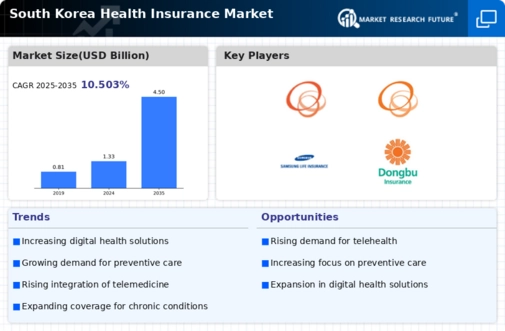Rising Healthcare Costs
Rising healthcare costs are a prominent driver influencing the health insurance market. In South Korea, healthcare expenditure has been increasing at an annual rate of approximately 6%, prompting consumers to seek more comprehensive insurance coverage. As out-of-pocket expenses rise, individuals are more inclined to invest in health insurance plans that offer extensive benefits. This trend compels insurers to innovate and provide competitive pricing while ensuring adequate coverage. The health insurance market is thus adapting to these economic pressures by developing plans that balance affordability with comprehensive care, ensuring that consumers are protected against escalating medical expenses.
Aging Population Dynamics
The aging population in South Korea is a critical driver for the health insurance market. As life expectancy increases, the demand for health services and insurance coverage rises. By 2025, it is projected that over 20% of the population will be aged 65 and older. This demographic shift necessitates more comprehensive health insurance plans that cater to chronic illnesses and long-term care. Insurers are adapting by offering products that address the specific needs of older adults, thereby expanding their market share. The health insurance market is likely to see a surge in policies that include preventive care and wellness programs tailored for seniors. This reflects the changing healthcare landscape.
Consumer Awareness and Education
Consumer awareness and education are increasingly influencing the health insurance market. As individuals become more informed about their health needs and insurance options, they are more likely to seek tailored coverage. Educational initiatives by insurers and government bodies aim to enhance understanding of health insurance products, leading to more informed purchasing decisions. This trend is evident in the growing interest in supplemental insurance plans that provide additional benefits beyond basic coverage. The health insurance market is thus responding by offering more transparent information and resources, enabling consumers to make choices that align with their health requirements and financial situations.
Government Policies and Regulations
Government policies and regulations play a pivotal role in shaping the health insurance market. Recent reforms aimed at enhancing universal health coverage have led to increased participation in the insurance sector. The government has introduced measures to regulate premium rates and ensure that essential health services are covered. These policies are designed to protect consumers and promote equitable access to healthcare. As a result, the health insurance market is experiencing a shift towards more standardized offerings, which may enhance competition among insurers. This regulatory environment encourages innovation while ensuring that consumers receive quality care at reasonable costs.
Technological Advancements in Healthcare
Technological advancements are reshaping the health insurance market in South Korea. The integration of telemedicine, artificial intelligence, and data analytics is enhancing service delivery and customer engagement. For instance, telehealth services have seen a significant uptake, with a reported increase of 30% in usage among insured individuals. Insurers are leveraging technology to streamline claims processing and improve customer service, which may lead to higher customer satisfaction and retention rates. Furthermore, the use of big data allows insurers to better assess risk and tailor products to meet the evolving needs of consumers, thus driving growth in the health insurance market.















Leave a Comment